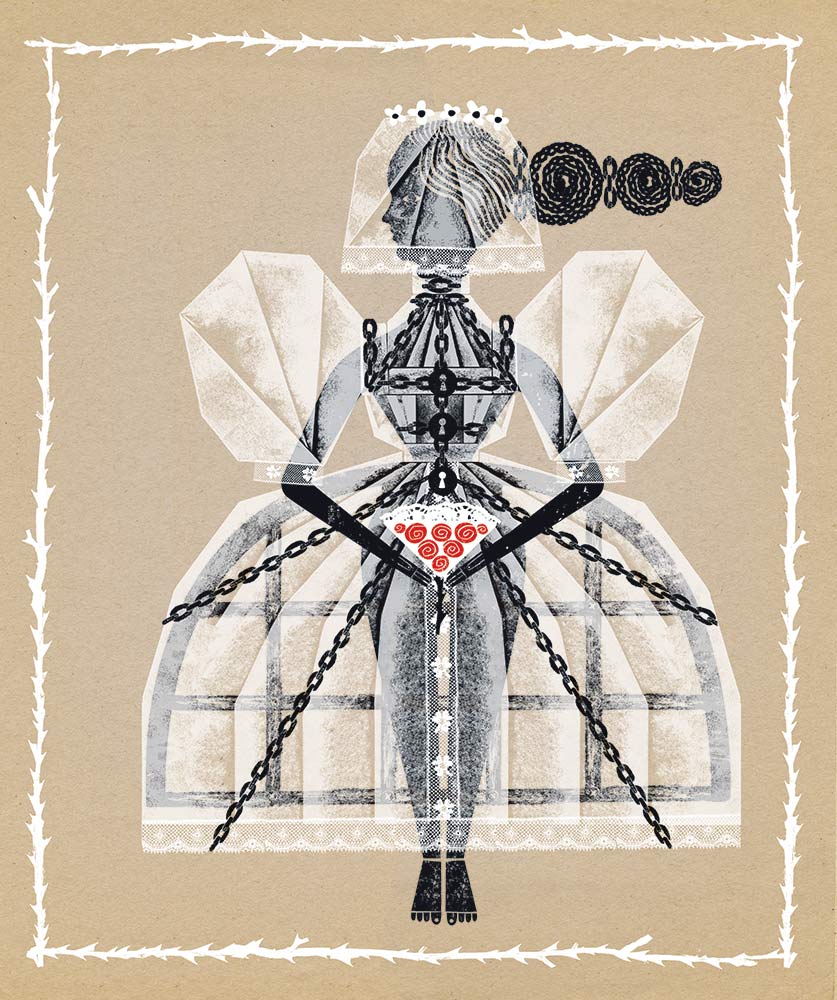The Silence of the Wives
Far from being an immutable fact of Christianity, evangelical antifeminism is recent, virulent, and gaining traction every day.
The Perfect, Smiling Wives of the Christian Right
Far from being an immutable fact of Christianity, evangelical antifeminism is recent, virulent, and gaining traction every day.

When Ruth was 21, she put on a wedding dress; it was high time, her parents and everyone else around her had said, for her to be married.
Growing up in the 1980s and 1990s in Bucks County, Pennsylvania, Ruth (a pseudonym to protect a victim of abuse) had been told over and over what it meant to be a woman—and marriage was at the center of it all. In Sunday school and Bible study, she had been taught that a wife’s role is to be submissive and accept her husband’s headship. Women were not allowed to address the congregation at her church. The faith she had grown up in was a “dark and bloody” one, she told me; in her Sunday school lessons, she had been taught to expect an imminent apocalypse that would annihilate the faithless and wreak vengeance on God’s foes.
In her community, dating was forbidden before the age of 16; at that point, young congregants were permitted to engage in strictly marriage-minded “courtships.” At a Bible study for teens and young adults, she watched her female peers ask for prayers that they could be more submissive to their husbands. Her sex education, such as it was, consisted primarily of a video series called Sex, Lies &…the Truth, featuring Focus on the Family’s James Dobson. All sex outside of marriage was a sin, and the only alternative was total chastity. Even kissing was prohibited before the wedding night.
At 19, she met the man she would marry—the first one who had ever asked her on a date. Over the course of their courtship, the man, a fellow student at her Christian high school, became sexually abusive. He began by groping her; when she refused his advances, they only became more forceful. In Dobson’s teachings, men cannot control their lust, and the burden is on women to ensure that they do not fall into sexual sin. Even as the assaults escalated into rapes, Ruth felt—and was encouraged to feel by her future husband—that the “sexual sin” was hers, even as he had her pinned down. She had not screamed loud enough, she had not managed to overpower him, and so she was to blame.
Ruth began to view herself as someone stained by the sin of enabling a man’s lust, someone impure and undeserving. When her future mother-in-law discovered condoms in her son’s room, she told Ruth’s parents that their daughter was sinning. In the ensuing months, her parents, future in-laws, and fiancé pushed her toward the sole solution they could see: ending the sin through the sacrament of marriage. So Ruth donned the dress and married the man who had raped her.
After all, she was an obedient Christian girl; she had internalized years of relentless teaching about sin, purity, and submission. Maybe the holy bond of husband and wife could erase all that had happened. “Marriage would help make it right,” she later told me.
Her future in-laws gave her a marriage manual offering a cure for women who suffered: prayer.
By the time of her wedding, Ruth had already begun to question the education she’d received about what it meant to be a woman. But it takes a long time to uproot a lifetime’s worth of indoctrination. So when the moment came, she walked down the aisle toward the man who had assaulted her, the man who, according to all she had been taught—through beatings and fire-and-brimstone sermons, through books and tapes and quiet Bible study sessions—ought to lead her through a life of wifely submission and child-rearing.
She had bought herself a dress tinted ivory rather than virginal white to show everyone that she had sinned, a quiet act of rebellion—one she performed while still unable to speak about what she’d endured. “I was trying so hard to assert myself,” she told me. Despite everything, she hoped that the sacrament of marriage would fix what was broken in him and in her. And so she said, “I do.”
What led Ruth to that moment—and what led her parents and church community to tell her to accept her abuse and repair it through submission? Was it an inevitable, fixed biblical truth—or a more recent invention?

From the very first debates about the story of Genesis, the role of women outlined in the Bible has been interpreted in many ways over the centuries. Some have focused on the heroism of Jael, impaling the skull of her foe in the Book of Judges; some on the sage judgments of Deborah; and others on the meekness prescribed by the Apostle Paul. But the contemporary, submission-oriented stringency toward women on the Christian right is relatively new, emerging as a response to the feminist movements of the 20th century. Even the term “complementarianism”—the notion that God created men and women to fulfill different roles—wasn’t coined until 1988. But through books, sermons, and DVDs, a new vision of femininity has taken hold across the conservative evangelical community. The rigidity of these gender norms cannot be exaggerated, nor can the Christian right’s fixation on the punitive enforcement of gender-appropriate behavior.
One of the most important books in the “Christian femininity” library, Let Me Be a Woman, by the wildly influential missionary Elisabeth Elliot, was published in 1976 explicitly as a rebuke to the women’s liberation movement. Part of a backlash against feminism, it helped formulate a new, unyielding view of what a woman should be that was the film negative of what women on the left were fighting for. In the preface, Elliot says as much: “This book was written at the height of the strong feminist movement that swept through our country in the seventies and eighties. Women were told that they ought to get out of the house and do something ‘fulfilling.’ They listened, and many discovered what men could easily have told them: that by no means is fulfillment necessarily to be found in any job…any more than in the kitchen. I knew that real satisfaction and joy come in response to acceptance of the will of God and nowhere else.”
In the book, Elliot scolds the feminist as being a monument to “immaturity.” The women’s movement is an evasion of responsibility, and a woman who asserts herself—who “defines her liberation as doing what she wants, or not doing what she doesn’t want”—is not only insulting God but is forfeiting her humanity. “By refusing to fulfill the whole vocation of womanhood,” Elliot writes, “she settles for a caricature, a pseudo-personhood.” To pursue your own will as a woman, in other words, renders you not God’s creature and even not fully human.
Elliot went on to be a mainstay in evangelical Christianity for decades, influencing the purity movement and other vital segments of right-wing Christian culture. But she was hardly the only Christian to respond with repulsion to the feminist movement. Throughout the 1960s, ’70s, and ’80s, feminists built power and transformed popular sentiment. They secured women’s rights to obtain a no-fault divorce; to own their own credit cards; to access housing without sex-based discrimination; to obtain contraception, whether they were married or unmarried; to serve on juries. In 1970, marital rape was legal in all 50 states; by 1993, all states had withdrawn the “spousal exception” to rape laws. In 1973, Roe v. Wade secured the federal right to obtain an abortion.

But Elliot and her ilk objected to the whole movement—to every right obtained, to every piece of economic security won. Abortion would eventually become the focal point of the Christian response to feminism, but initially, the conservative Christian movement did not make abortion the primary target of its animus. Instead, its emphasis was on making clear that a woman whose goal was not submission within the confines of heterosexual marriage was an affront to God.
By the 1980s, the anti-feminist backlash within Christian movements had hardened into something permanent. And through the assiduous efforts of right-wing theologians, politicians, and scholars, it had begun to acquire the patina of ancient biblical truth.
In 1987, in Dallas, a group of influential evangelical theologians—two of whom were named Wayne, and all of whom have had long and influential careers on the Christian right—met to create a new organization, the Council on Biblical Manhood and Womanhood. According to the council’s statement on its history, that meeting was inspired by “the spread of unbiblical teaching” during the burgeoning and expanding feminist movement.
Under the leadership of John Piper, a theologian and pastor and the founder of the Desiring God ministry, the group outlined, according to its website, “what would become the definitive theological articulation of ‘complementarianism,’ the biblically derived view that men and women are complementary, possessing equal dignity and worth as the image of God, and called to different roles that each glorify him.”
In December 1987, in Danvers, Massachusetts, the newly founded Council on Biblical Manhood and Womanhood formulated the Danvers Statement, a response not just to feminism in the culture at large but to the nascent Christian feminist movement, which had sought to reimagine gender roles within evangelical churches.
Expressing its concern with “the increasing promotion given to feminist egalitarianism with accompanying distortions or neglect of the glad harmony portrayed in Scripture between the loving, humble leadership of redeemed husbands and the intelligent, willing support of that leadership by redeemed wives,” the council laid out an image of Christian manhood and womanhood that would thoroughly repudiate any vision of a Christian feminist future. “Ambivalence regarding the values of motherhood [and] vocational homemaking” was excoriated, alongside the emergence of roles for women in church leadership that were “crippling to Biblically faithful witness.”
In response to those purported societal cataclysms, the group presented principles that it believed would lead Christians from a path of damnation back toward the loving arms of God: “In the family, husbands should forsake harsh or selfish leadership and grow in love and care for their wives; wives should forsake resistance to their husbands’ authority and grow in willing, joyful submission to their husbands’ leadership.”
Not content to simply issue such a proclamation, the ministers and theologians who created it set about ensuring that it was adopted by as many millions of Christians as possible. In 1989, the group published a full-page advertisement containing the entire Danvers Statement in Christianity Today, a flagship evangelical publication founded in 1956 by the legendary evangelist Billy Graham; in the 1980s, each issue of the magazine reached tens of thousands of Christians. A pressure campaign, including a 1991 anthology called Recovering Biblical Manhood and Womanhood: A Response to Evangelical Feminism, helped spread complementarian theology nationwide.
Eventually, the council would claim that its “gospel-driven gender roles” had been adopted by major Protestant denominations, including the Presbyterian Church in America and the Southern Baptist Convention, which together represent more than 10 million parishioners. The impact of the Danvers Statement on major Protestant denominations is impossible to overstate.
The notions of biblical manhood and womanhood, so recently invented, acquired a retroactive imprimatur of divinity, folded into sermons, marriage counseling for young couples, and education for future brides.
Christian conservatism benefits from the construction and adulation of an imagined, purer past—a time unsullied by the feminist movement. That is why these marriage manuals fixate on the Garden of Eden, old-school Hollywood fantasies, and 1950s home ec. Cherry-picked history coincides with cherry-picked Scripture; what is, in fact, a specific reaction to social change is recast as divine mandate—the inerrant word of God, the essential and unchanging nature of mankind since its creation.
Some stories do have a beginning; this one has a particularly famous opener. In Genesis 2—one of three versions of the creation story—God makes Eve because he decides it is not good for Adam to be alone. Some impromptu heavenly surgery occurs (complete with spiritual anesthesia!), and a rib is extracted from Adam, which God transforms into Eve, so that she may function as a “help meet” to Adam. “Help meet” is the King James Bible’s translation of the enigmatic Hebrew phrase ezer k’negdo, which means something like a “helper to suit him”—“meet” in the archaic sense of “fitting,” as in a being created to aid another. Eve’s condition as a help meet has formed the basis of countless guides to Christian marriage, ones that emphasize the submission of women to their husbands and advance the notion that a woman without a husband is both incomplete and untrue to her “created nature.”

In 2004, Debi Pearl, a nationally famous Christian figure and the wife of the right-wing pastor Michael Pearl, laid out her stark vision of this idea in her book Created to Be His Help Meet: Discover How God Can Make Your Marriage Glorious. It’s the companion to her husband’s book Created to Need a Help Meet: A Marriage Guide for Men, and it is a large-font, sweetly decorated instruction manual on how to build yourself a lifelong prison.
The book has sold some 500,000 copies in 12 languages, according to its 10th-anniversary edition; it was reissued in 2014 and 2019. One friend who grew up in an evangelical context disclosed that she had been given three copies of Pearl’s marriage manifesto upon becoming a bride. Another woman told me that her mother had given her the book as soon as she began to menstruate, to preview her future as a wife: “It was traumatizing.”
Drawing from Genesis, Pearl asserts that women who are not married to men—and, furthermore, women who are married to men but do not assume the submissive role of help meet—are forsaking the role for which God created them. Such a departure is aberrant, abhorrent to God. Women who work outside the home are also forsaking their role of help meet; female employment, Pearl writes, “leads to family ruin.” A woman may not lead her household either; she is instructed to accept her husband’s leadership, even if it is poor, as being superior to her assertion of self.
The perfect Christian woman Pearl envisions is always happy; her smile (much emphasis is placed on the necessity of a constant smile and a merry heart) is what draws her husband to her. “Being pitiful, hurt, discouraged, and even sickly is one side of a ‘bad marriage’ coin,” she writes. “Men, in general (your husband in particular), are repulsed by women who project this image…. He will react with anger.”
Women who are being abused must neither fight back (“with the voice of a shrew and the demeanor of a feminist”) nor “cower” and “brainlessly submit”—but rather display honor, reverence, and obedience to their husbands. In the spirit of Christ, they must “put on the whole armor of God” in order to “endure abusive words without feeling abused.” Women who complain about their abusers, who leave relationships, or who do not marry are addressed in a section titled “Disappointed Old Failures.”
Pearl’s writings are generally viewed as an extreme version of complementarianism. Nonetheless, Christian marriage guides with similar messages—even if delivered in softer tones, adorned with rose-blush pink covers and images of couples embracing—are legion; they fill bookshelves with their messages of the meek and quiet spirit, of the wife who never leads and only follows. Most of these books are neither particularly old—many of the “classics” currently in multiple reprints were released in the mid-2000s—nor obscure; though aimed at a Christian audience, they seek to appeal to any woman who wishes her life or relationship could be better and offer, as a solution, a theological straitjacket lined with the faux softness of gentle advice.
Popular
“swipe left below to view more authors”Swipe →In Captivating: Unveiling the Mystery of a Woman’s Soul, rereleased in 2021 in an expanded edition 16 years after its initial publication, the popular Colorado-based husband-and-wife ministers John and Stasi Eldredge couch a brutally confined view of sacred femininity in soft-edged prose and bland pop culture references. Since the expulsion from Eden, the Eldredges write, “Woman is cursed with loneliness (relational heartache), with the urge to control (especially her man), and with the dominance of men.”
Despite the book’s conversational tone—that of a gentle friend and confidant—the warning of the book is stark: When a woman is “grasping, reaching, controlling”—when she seeks to control and dominate her environment and those around her—she is “falling prey to the lies of our Enemy,” Satan. There is no way to run this gauntlet successfully except to surrender one’s control and self-protection, trust only in God and husband, and “return to our God with broken and desperate hearts.” All other paths lead to divorce and damnation—options presented as equally devastating.
The view of femininity advanced by this pink-hued surge of rigid rhetoric—not only in books, but in sermons, marriage seminars and workshops, and podcasts—is not necessarily confined to Christianity: The Eldredges hold up Renée Zellweger’s pathologically self-effacing character in Jerry Maguire as a model; Pearl cites a home economics textbook from 1950; and it is all bulwarked by carefully chosen verses, chains of domestic servitude disguised as the armor of God.
The Christian right’s expectations of women—submission and obedience, labor and servility—have no flexibility; any deviation is a fall from grace into mortal sin. But submission and obedience without question are easily abused. The pliant Christian wife suffers; when she is abused, she turns not to earthly authority but to God for her answers. Though some manuals offer caveats in cases of severe physical abuse, anything short of bruises is readily explained; in Pearl’s telling, a husband who feels insufficiently adored can become angry and violent, and the solution is not to escape or even fight back but to become a font of grace.

By the time Ruth was a teenager in 1990s Pennsylvania, the biblical womanhood prescribed by the Danvers Statement had been transformed from the adages of pastors into the timeless wisdom of God. She was taught that submission, obedience, and purity were the highest values a woman could hold. As she married the man who had raped her again and again, she had yet to fully reject the teachings so deeply and deliberately ingrained in her.
Remember that marriage manual her future in-laws gave her? During her engagement, Ruth received The Power of a Praying Wife by Stormie Omartian, a Christian manual first published in 1996 that teaches married women how to endure suffering. Omartian’s husband, Michael, a Christian musician with three Grammys to his name, writes a one-page foreword in which he relates a little joke he has become fond of telling over the decades: “It’s been twenty-five wonderful years for me and twenty-five miserable years for her.”
One chapter in, it becomes clear that this isn’t much of a joke—if it ever was. “I confess right now there was a time when I considered separation or divorce,” Stormie Omartian writes. “The last thing I want to do is grieve God. But I know what it’s like to feel the kind of despair that paralyzes good decision making…. I’ve felt pain so bad that the fear of dying from it propelled me to seek out the only immediately foreseeable means of survival: escape from the source of agony.”
Her husband, the flagship music producer for the organization Cru, formerly known as Campus Crusade for Christ, had, she alleges in her book, wounded her repeatedly. “The only ones that were ever the object of his anger were me and the children. He used words like weapons that left me crippled or paralyzed,” she writes. “A husband can hurt your feelings, be inconsiderate, uncaring, abusive, irritating, or negligent. He can say or do things that pierce your heart like a sliver.”
Stormie Omartian found her solution in what she described as a kind of death. Clutching her Bible on her bed after once again considering separation, she decided instead to let her own will be extinguished: “As I sat there, God impressed upon my heart that if I would deliberately lay down my life before His throne, die to the desire to leave, and give my needs to Him, He would teach me to lay down my life in prayer for Michael.”
And she did so for that quarter-century—so wonderful for him, so miserable for her, and so full, so very full, of prayer. The ultimate prescription for women in this milieu is a kind of living martyrdom, a suicide of self that must be repeated every day. It is this view that dominates the lives of tens of millions of American women and fuels the kind of legislation that sees women not as conscious actors but as beings whose bodies and souls can and must be subject to absolute control.
As for Ruth? The seed of rebellion that had begun with buying her off-white dress continued to grow within her. Despite pressure from her husband, her church community, and her parents, she refused to bear children for her abuser. She had decided she would not inflict on her children what had been inflicted on her by her parents: threats and beatings, with implements and without, for reasons so small, she told me, that they would “break your heart.” Throughout nearly a decade of marriage, her husband berated her; he abused her sexually; he shamed her in the church community and among their families for her failings as a wife. She stayed with him like the good Christian woman she’d been raised to be, even as she worked to unravel the internal bonds that kept her tied to that image of suffering femininity. She endured it all—until she didn’t anymore.
Ruth left the faith she was raised in, and then any faith at all, and then the husband who had used God as a weapon against her. She refused to die to herself, to let her own will die. She left him without a prayer on her lips but with hope in her heart. She is in her 40s now, and as she spoke to me, her lively children interrupted her. She works to help other people who have left evangelicalism to root out the pain and shame instilled into them. It took her a long time, she told me, to figure out what a healthy relationship looks like. But she did.
Disobey authoritarians, support The Nation
Over the past year you’ve read Nation writers like Elie Mystal, Kaveh Akbar, John Nichols, Joan Walsh, Bryce Covert, Dave Zirin, Jeet Heer, Michael T. Klare, Katha Pollitt, Amy Littlefield, Gregg Gonsalves, and Sasha Abramsky take on the Trump family’s corruption, set the record straight about Robert F. Kennedy Jr.’s catastrophic Make America Healthy Again movement, survey the fallout and human cost of the DOGE wrecking ball, anticipate the Supreme Court’s dangerous antidemocratic rulings, and amplify successful tactics of resistance on the streets and in Congress.
We publish these stories because when members of our communities are being abducted, household debt is climbing, and AI data centers are causing water and electricity shortages, we have a duty as journalists to do all we can to inform the public.
In 2026, our aim is to do more than ever before—but we need your support to make that happen.
Through December 31, a generous donor will match all donations up to $75,000. That means that your contribution will be doubled, dollar for dollar. If we hit the full match, we’ll be starting 2026 with $150,000 to invest in the stories that impact real people’s lives—the kinds of stories that billionaire-owned, corporate-backed outlets aren’t covering.
With your support, our team will publish major stories that the president and his allies won’t want you to read. We’ll cover the emerging military-tech industrial complex and matters of war, peace, and surveillance, as well as the affordability crisis, hunger, housing, healthcare, the environment, attacks on reproductive rights, and much more. At the same time, we’ll imagine alternatives to Trumpian rule and uplift efforts to create a better world, here and now.
While your gift has twice the impact, I’m asking you to support The Nation with a donation today. You’ll empower the journalists, editors, and fact-checkers best equipped to hold this authoritarian administration to account.
I hope you won’t miss this moment—donate to The Nation today.
Onward,
Katrina vanden Heuvel
Editor and publisher, The Nation








